ISSN
2307-3489 (Print), ISSN 2307-6666 (Online)
Наука
та прогрес транспорту. Вісник
Дніпропетровського
національного
університету залізничного транспорту,
2016, № 4
ЗАЛІЗНИЧНА
КОЛІЯ
UDC
625.141.54:625.172
N.
P.
NASTECHIK1,
R. V. MARCUL2*
1Dep.
«Track
and Track Facilities»,
Dnipropetrovsk
National University of Railway Transport named after Academician V.
Lazaryan, Lazaryan St., 2, Dnipro, Ukraine, 49010, tel. +38
(056)
373
15
31,
е–mail
nastechik_mp@mail.ru,
ORCID
0000-0002-4178-6092
2*Dep.
«Track
and Track Facilities»,
Dnipropetrovsk
National University of Railway Transport named after Academician V.
Lazaryan, Lazaryan St., 2, Dnipro, Ukraine, 49010, tel. +38
(056)
373
15
31,
е–mail
guaranga_mr@mail.ru,
ORCID
0000-0002-7630-8963
PROSPECTS
FOR LAYING THE FASTENING
OF THE TYPE СКД65 - Б IN THE CURVESD
TRACK SECTIONS WITH SMALL RADIUS
Purpose.
To
date, according to the order of Ukrzaliznytsia it was decided to
fully transit the main tracks to the concrete sleepers. The reason
for this is the lack of wooden sleepers, their high cost and low
lifetime that in the curved track sections with the radius R≤300 m
is only 5-7 years (this is 5 times less than the lifetime of concrete
sleepers).
After introduction of fastening type СКД65-Б it is possible to
smoothly expand the track from 0 mm to 14 mm, and to narrow from
0 mm to 28 mm with a step 1 mm. At the increased train
load on the track of 75...130 kN in a horizontal plane, which is
characteristic for the curved track sections R≤300 m the
violations in terms of track geometry often take place. It results in
the frequent surfacings, periodicity of which at the fastening type
СКД65-Б is absent for today. Therefore the purpose of the article
is the development of recommendations concerning maintenance of the
track in a plan with the fastening type СКД65-Б. Methodology.
The
methodology of research is based on the comparative estimation of
influence of the track width change dynamics on the periodicity of
surfacing in the plan in the case of the use of fastening type ДО
and СКД65-Б.
Findings.
With the help of the developed research methodology it was
established that the first implementation of adjusting the track
width at fastening type ДО is necessary to be executed on the 14th
month and at the fastening type СКД65-Б on the 28th
month of operation.
Originality.
It was first described and expressed using the empiric dependence the
process of the track width change, and periodicity of its adjusting
in the case of the fastening type СКД65-Б use. Practical
value.
The developed recommendations will allow in time to execute adjusting
of the track width at fastening type СКД65-Б and ensuring the
safety of train motion at the same time.
Keywords:
fastening
type
СКД65-Б; track width; adjusting of track width; maintenance of
track in plan
Introduction
Increase
in the train speeds, axial loading at the Ukrainian railways
requires increase in the strength and stability of the railway
track. Today, in the vast majority of cases in small radius curves,
especially in the areas of Lviv railway it is operated the track
with wooden sleepers and fastening type ДО.
In
the initial stages of operation the track on wooden sleepers has
little stiffness that provides three-dimensional elasticity of the
track superstructure (hereinafter TS) elements at the simultaneous
perception of both vertical and horizontal dynamic forces from the
rolling stock. During the maintenance work wooden sleeper, unlike
the concrete sleepers, undergoes rapid replacement with the new one
without significant labor costs.
Despite
the advantages, wooden sleepers have several disadvantages that make
economically unprofitable their use. The
reason for this is the lack of wooden sleepers, their high cost and
low lifetime that in the curved track sections with the radius
R≤300 m is only 5-7 years. This is 5 times less than the
lifetime of concrete sleepers
[10].
During
operation of the railway track in the curved sections of small
radius with wooden sleepers and fastening type ДО
the rail thread thrust occurs. It leads to the deviations from the
tolerances
of rail
track width [6,
12].
When the track width exceeds the tolerances it is necessary to carry
out regaging, which largely affects the life of wooden sleepers.
Production
of sleepers of softwood species also results in the fact that in the
short term the metal baseplate, which is the element of the
fastening type ДО,
cuts into the wood fibers [3-6,
10, 12-15].
During production of wooden sleepers their manufacturing technology
based on insufficient seepage is violated. This leads to sleeper
rotting and reduction in its operating lifetime in the track [12].
To
date, according to the order of Ukrzaliznytsia it was decided to
fully transit the main tracks to the concrete sleepers.
To
date, according to the order of Ukrzaliznytsia there is a tendency
to transition to the concrete sleepers in curves of small radius, in
connection with the increased speed of trains, axial loads and
freight traffic on the railway. At the same time the increase in
strength and stability of railway track is required.
With
the fastening type СКД65-Б
(Fig.
1) [1,
7],
there is a possibility to use the concrete sleepers in curved track
sections of small radius without construction modification of the
sleeper type of Ш1-1.
The use of concrete sleepers and fastening type СКД65-Б
makes it possible to avoid many of the problems arising in the
railway track on wooden sleepers with the fastening type ДО.
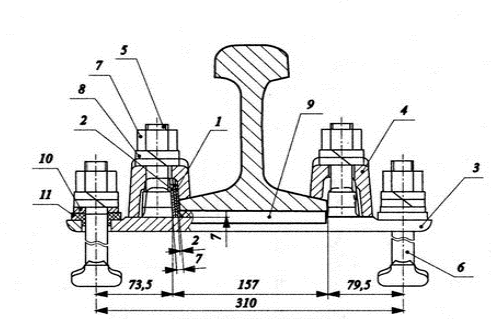
Fig.
1. The СКД65-Б type of fastening
1
-
аdjusting card,
2 mm width (two items);
2
- аdjusting card, 3 mm width (one item);
3
- plate 2КБЛ65;
4
-
terminal ПКЛ;
5
-
terminal bolt;
6
-
insert bolt; 7
-
screw nut;
8:
double coil washer; 9
-
plate ПРБ-4;
10
-
plain washer ШП-1.1;
11
-
insulating sleeve
At
the fastening type СКД65-Б it is allowed to build into the
curves of radius between 450 m to 200 m
concrete sleepers with distribution diagram of sleeper laying 1.840
units/km. At this the fastening СКД65-Б
ensures
a smooth transition of width in the transition curves for expansion
from 0 mm to 14 mm and narrowing from 0 mm to 28 mm. In a circular
curve using the fastening type СКД65-Б
one
can set the pattern 1534 mm using the concrete sleepers of type Ш1-1
according to the works [1,
7, 16].
At
the increased train load on the track of 75...130 kN in a
horizontal plane, which is characteristic for the curved track
sections R≤300 m the violations in terms of track geometry
often take place [9].
It results in the frequent surfacings, the periodicity of which at
the fastening type СКД65-Б is absent for today. Therefore the
purpose of the article is the development of recommendations
concerning maintenance of the track in a plan with the fastening
type СКД65-Б.
Purpose
Therefore
the purpose of the article is the development of methods and
recommendations concerning maintenance of the track in a plan with
the fastening type СКД65-Б.
Methodology
The
methodology of research is based on the comparative estimation of
influence of the track width change dynamics on the periodicity of
surfacing in the plan and adjusting of its width at the fastening
type ДО and СКД65-Б.
In
2015, on one of the Ukrainian railways two curved track sections
with the radius of 350 m were chosen. At the one track section was
laid the track panel (further TP) with wooden sleepers and fastening
ДО,
and the second TP with the concrete sleepers and fastening СКД65-Б.
The width measurements were executed after laying of two TP for five
months, every 10 meters along the length of the curve.
When
performing the measurements on each of the sections there were
studied various additional factors, the probability of which can
affect the process of changing the width of the rail track.
At
TP with wooden sleepers it was observed the influence of such
factors as side wear of the outer railway line, sloping caused by
indentation of metal baseplate into the wooden sleeper. At TP with
concrete sleepers it was mainly observed the change of track width
due to the side wear of the outer railway line.
Using
the obtained statistics there were determined the average values of
track width change at the type fastening ДО
and
СКД65-Б
in the curve with radius of 350 m over five months, which are
presented in the Table 1.
Table
1
Mean
values of track width for each month
-
|
Fastening
type in the curve
|
Mean
value of the track width,
mm
|
|
November
|
December
|
January
|
February
|
March
|
|
1
|
2
|
3
|
4
|
5
|
6
|
|
ДО
|
1529.35
|
1529.76
|
1530.35
|
1531.06
|
1531.71
|
|
СКД65-Б
|
1531
|
1531.24
|
1531.47
|
1531.71
|
1531.94
|
Mean values
of the track width change at the two track sections with the
fastening type ДО
and
СКД65-Б
during five months of operation are shown in the Fig. 2-3.
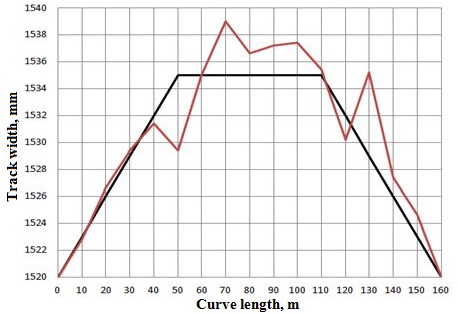
Fig.
2. Change of track width at fastening of
type
ДО
for five months
According to
the two-factor dispersion analysis [8] taking into account the above
mentioned impacts, it was established the criterion of influence «F»
on the track width change:
Observation
results of the track width change at the track sections with the
fastening type ДО
and
СКД65-Б,
depending on the time parameter, presented as coordinate pair ''х''
and
''у''
were approximated [8] (Fig. 4-5 ).
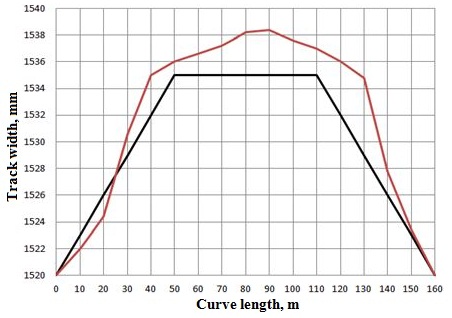
Fig.
3.
Change
of track width at fastening of
type
СКД65-Б
for five months
According to
the approximation results in the Fig. 4-5 one can clearly see that
the change of the track width with the fastening type ДО
and
СКД65-Б
is linear, which can be described by the function:

where
 - are
the constant parameters.
- are
the constant parameters.
Function
parameters (1) using the method of least squares [8] can be
described by the following set of equations:
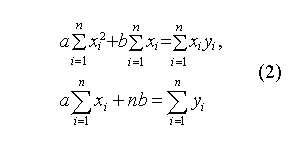
where
 - are
the measured coordinates of the
- are
the measured coordinates of the
 -th
point;
n- is
the
number of points with measured
coordinates.
-th
point;
n- is
the
number of points with measured
coordinates.
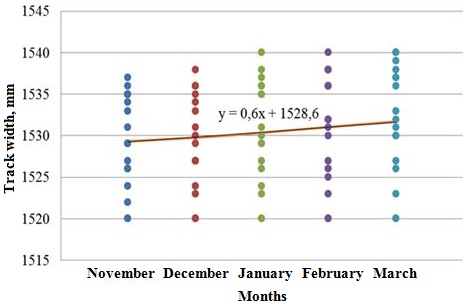
Fig.
4. Change of track width at fastening of type ДО

Fig.
5.
Change
of track width at fastening of type СКД65-Б
Recommendations
concerning the frequency of track width adjustment
On the basis
of the work [11] the state of track upon the condition of its
expansion according to the tape of track measurement car is
evaluated in points. According to our case for the studied track
sections with radius
 ,
the track state according to the width based on evaluation scores
will be fined:
,
the track state according to the width based on evaluation scores
will be fined:
According to
the obtained function (1) it was determined the time, when the track
regaging (with the fastening type ДО)
and track width adjusting (with the fastening type СКД65-Б)
should be carried out. For clarity the frequency diagram of track
width adjustment in the curve radius of 350 m with two types of
fastening was constructed (Fig. 6).

Fig.
6. Frequency of adjusting the track width of
in
the curve of R=350 m at fastenings
of
type ДО
and
СКД65-Б
This
diagram shows that after the first track width adjustment at the
section with fastening type ДО,
the next adjustment is carried out every three months and at the
curve with fastening type СКД65-Б
every 7 months.
According to
the papers [7, 8] at the TP with wooden sleepers the spike fastening
holes already broken after the third regaging this almost eliminates
a tight pressing of rail to the rail seat using the spikes.
The proposed
methodology of periodicity of the track width adjusting upon the
condition of its widening at the fastening type ДО
and
СКД65-Б was
based not on the complete elimination of widening but on the
bringing to the appropriate state of retreat from the existing
state, where the evaluation in points, at which the section will be
fined that was the part of the range "good".
Based on the
above mentioned data, and methodology track maintenance upon the
condition of its widening, it is proposed to adjust the width of the
track when using the intermediate rail fastening of type ДО
and
СКД65-Б under
the schemes presented in the Figures 7-8.

Fig.7.
Adjusting of track width in the studied curve with fastening of type
ДО
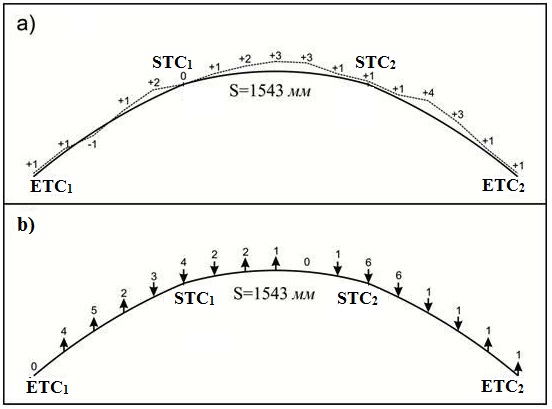
Fig. 8.
Adjusting of track width in the
studied
curve with fastening of type СКД65-Б
The Figures
7a and 8a show the existing condition dashed line of the track width
in curves with the dashed line, and the project condition with the
solid line. The numbers show by how many millimeters the existing
track width is greater (+) or less (-) than the project one. The
arrows up or down in the Figures 7b and 8b show how it is necessary
to expand or narrow the track (in mm) during operation of the
railway track with the fastening type ДО
and
СКД65-Б.
Technical
and economic efficiency of the proposed recommendations
A separate
challenge was to determine the technical and economic efficiency
from laying the railway track construction with concrete sleepers in
curves of small radius with fastening type СКД65-Б,
as compared to the railway track with wooden sleepers and fastening
of type ДО.
During the
studies it was used a methodology, which allows to analyze the
cost-effectiveness of TS variant throughout the repair interval of
operation [2]. This methodology is based on the analysis of total
reduced costs:

where
Кі
– are
the capital investments
for
laying of і-th
variant of track design,UAH/km (the cost for capital
repairs of the track);
Еti
–
is the
annual operating costs of the i-th variant,
UAH/km
per year;
Сі
– is
the simultaneous
costs (for
complex and recreational medium and other repairs) on the i-th in
each year tі,
UAH/km;
tі
– is
the year, in which the costs are determined;
tкр
– is
the lifetime
of the
most
long-term variant
of the track construction;
ηt
– is
the cost reduction coefficient of (discount coefficient).
The cost
reduction coefficient is determined by the following formula:

The
calculation methodology was based on the calculation of one
kilometer of track consisting of curves and straight sections.
During calculations the most optimal variants of the track
construction from the following ones were accepted (Fig. 9):
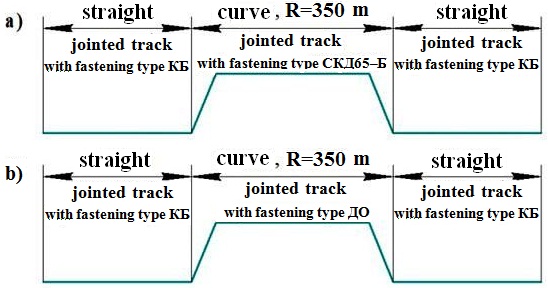
Fig.
9 Possible variants of track construction replacement
а)
variant
1; b)
variant
2
Labor costs
are determined by the expression:

where
 - is
the hourly tariff rate corresponding to the fourth category;
- is
the hourly tariff rate corresponding to the fourth category;
 - is
the
total number of elements
that are
changed
at different current repairs and maintenance;
- is
the
total number of elements
that are
changed
at different current repairs and maintenance;
 -
is
the time required for replacement of the і- th element og
TS.
-
is
the time required for replacement of the і- th element og
TS.
The
cost of materials is determined by the expression:

where
 is
and cost of the і-th
element of the TS.
is
and cost of the і-th
element of the TS.
Chart of the
total reduced costs that makes it possible to determine the payback
period of laying the track construction with the fastening type
СКД65-Б
as
compared to the construction of the track with the fastening type ДО
is
shown in the Fig. 10.
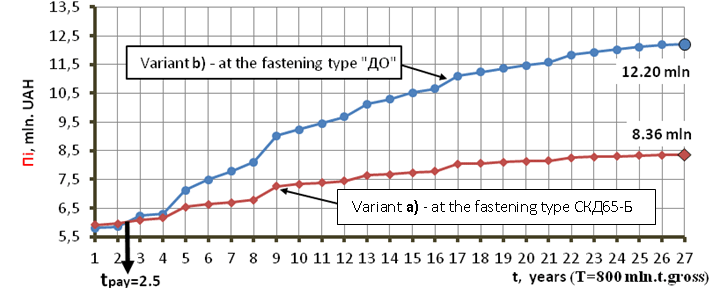
Fig.
10 Chart of the total reduced maintenance costs of railway track
with fastening of
type
ДО and СКД65-Б
From the
graph of total reduced costs (Fig. 10) it was established that the
savings for 1 km railway track when laying the concrete sleepers in
the curve of radius 350 m with the fastening type СКД65-Б
is
31.5%. This is mainly due to the reduction of the time required to
perform the works at the current maintenance and material savings of
TS.
At the
current maintenance of one kilometer of railway track with
intermediate rail fastening of the type СКД65-Б
the annual saving is 72.6% of the costs for existing regulations of
maintenance (wooden sleepers, fastening type ДО),
which is shown in the Fig. 11.
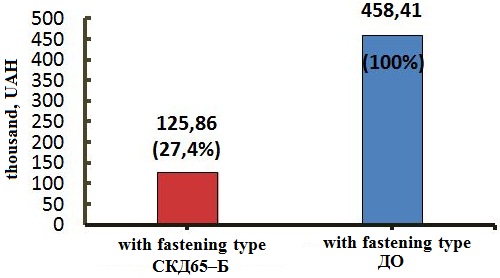
Fig.
11 The economic effect of the current maintenance of 1 km of railway
track
When laying
the concrete sleepers in curves with radius less than 350 m with the
fastening of the type СКД65-Б
according to the above mentioned studies it is reduced the number
regagings and adjustings of the rail track width.
Thus, the
number of regagings for the entire turnaround time (27 years, 800
mln. tons gross) is approximately:
Findings
Using the
above mentioned studies it was found that the frequency of rail
track width adjustment in the curve with radius of 350 m at the
intermediate rail fastening СКД65-Б
is twofold reduced as opposed to the fastening type ДО.
The railway track width adjustment with the fastening type ДО
is required on the 14th month and with the fastening of СКД65-Б
type on the 28th month of the railway track operation.
Originality
and
practical
value
For the first
time it was comprehensively studied, described and expressed by the
empirical dependence the process of changing the track width and the
frequency of its adjustment in the case of fastening type
СКД65-Б.
Presented
preliminary studies and recommendations make it possible to perform
rail track width adjustment with the fastening of type СКД65-Б
in time. This will partly prevent and eliminate further development
defects of the rail track in plan occurring during its operation
with simultaneous ensuring the safety of train motion.
Conclusions
The work
represents the studies, which are based on comparative assessment of
the influence of the track width change on the periodicity of
correction and adjusting its width at the fastening of type ДО,
and СКД65-Б.
It was chosen two curved sections of track with curve radius of 350
m. On the one section was laid the TP on wooden sleepers with the
fastening type ДО,
on the second section was the TP on concrete sleepers with the
fastening type СКД65-Б.
The track
width change at the above mentioned railway sections was
investigated within five months of operation. Using the above
mentioned data of the field tests it was for the first time
established the frequency of rail track width adjustment with the
fastening of СКД65-Б type
during operation.
The first
adjustment of track width in the curve radius of 350 m with the
fastening of type СКД65-Б
should be performed at the 28th month of operation (then every 7
months), and with the fastening of type ДО
on wooden sleepers on the 14th month (then every 3 months).
Using the
technical and economic calculations it was established that, unlike
the track structures on wooden sleepers with the fastening type ДО,
in case of laying the concrete sleepers with the fastening type
СКД65-Б the economy for 1 km of railway track for the entire repair interval
is 31.5%. At the current maintenance for 1 km of railway track the
annual economy is 72.6%.
It was
established possible number of the track for width adjustment for
the entire turnaround time (800 mln. tn. gross) with concrete
sleepers and the fastening type СКД65-Б decreased in 59 times.
LIST
OF REFERENCE LINKS
Губар,
О. В. Конструкція скріплення типу
СКД65-Б, можливості його застосування
та визначення ділянки відводу розширення
в межах перехідної кривої / О. В. Губар,
М. П. Настечик // Проблеми та перспективи
розвитку залізн. трансп. : тези доп. 69
Міжнар. наук.-практ. конф. / Дніпропетр.
нац. ун-т залізн. трансп. – Дніпропетровськ,
2009. – С. 155.
Даніленко,
Е. І. Залізнична колія : підруч. для вищ.
навч. закл. : у 2 т. / Е. І. Даніленко. –
Киів : Інпрес, 2010. – Т. 1. – 528 с.
Каменский,
В. Б. Содержание железнодорожного
пути в кривых / В. Б. Каменский, Э. Я. Шац.
– Москва : Транспорт, 1987. – 189 с.
Лысюк,
В. С. Износ деревянных шпал и борьба с
ним / В. С. Лысюк // Тр. ЦНИИ МПС. –
Москва : Транспорт, 1971. – Вып. 445. – С.
3–220.
Лысюк,
В. С. Экспериментальные исследования
сопротивления рельсовой нити распору
в условиях обращения тяжеловесных
поездов / В. С. Лысюк, А. В. Переслечин,
Е. В. Суворов
// Скорости движения поездов в кривых
: сб.
науч. тр. /
ВНИИЖТ. –
Москва : Транспорт, 1988. – С. 50–60.
Пат.
31032 Україна, МПК7
Е 01 В 9/44 Рейкове скріплення / О. В. Губар
М. П. Настечик, П. В. Рагулін, В. В. Рибкін,
К. В. Корноухова, В. О. Яковлев.
–№ 200712086 ; заявл. 01.11.2007 ; опубл.
25.03.2008, Бюл. № 6. – 3 с.
Рибкін,
В. В. Надійність залізничної колії :
навч. посіб. / В. В. Рибкін, І. О.
Бондаренко, Д. М. Курган. – Дніпропетровськ
: ДНУЗТ, 2013. – 154 с.
Рибкін,
В. В. Оцінка впливу величини
бічної-горизонтальної сили, що
передається на вузол проміжного
рейкового скріплення типу КБ та
КПП-5
/ В. В. Рибкін, І. О. Бондаренко, Р. В. Маркуль
/ Проблеми взаємодії колії та рухомого
складу : пр. Міжнар. наук.-практ. конф.,
присв. 100-річчю проф. М. А. Фрішмана /
Дніпропетр. нац. ун-т залізн. трансп. –
Дніпропетровськ, 2013. – С. 38–39.
Рыбкин,
В. В. Исследование вопросов внедрения
конструкции бесстыкового пути на
железобетонных шпалах в кривых радиусом
R≤350 м
/ В. В. Рыбкин, Н. П. Настечик,
Р. В. Маркуль
// Тр. X-ой науч.-техн. конф. с междунар.
участием / Моск. гос. ун-т путей сообщ.
– Москва, 2013.
– С. 198–201.
Технічні
вказівки щодо оцінки стану рейкової
колії за показниками колієвимірювальних
вагонів та забезпечення безпеки руху
поїздів при відступах від норм утримання
рейкової колії : затв. наказом Укрзалізниці
№ 033 Ц від 01.02.2012. – Киів : М-во
інфраструктури України, 2012. – 48 с.
Фришман,
М. А. Как работает путь под поездами /
М. А. Фришман. – 4-е изд., перераб. и доп.
– Москва : Транспорт, 1987.
– 189 с.
Яхов,
О. П. Особенности перешивки колеи на
старогодных шпалах при проведении
унификации ширины колеи / М. С. Яхов, О.
П. Ершков // Тр. ВНИИЖТа.
– Москва, 1960. – Вып.
192
: Ершков
О. П.
Расчеты железнодорожного пути в кривых
и нормы его устройства / О. П. Ершков,
Л. П. Мелентьев, М. С. Яхов. – С. 146–149.
Ahlf,
R. Matching M/W practice to require use of track / R. Ahlf // J. RT
& S (Railway Track & Structures). – New York, 2016. –
Vol. 10. – P. 2–3.
Baluch,
H. Diagnostyka nawierzchni kolejowej / H. Baluch. – Warszawa :
Wydawnictwa komunikacji i lacznosgi, 1978. – 415 p.
Lichtberger,
B. Track Compendium. Formation, Permanent Way, Maintenance,
Economic / B. Lichtberger. – Hamburg : Eurailpress, 2005. –
634 p.
Rybkin,
V.
V.
Stability
issues
of
the
continuous
welded
rail
track
on
the
concrete
sleepers
on
the
curves
with
radius
R≤300
m.
/ V.
V.
Rybkin
N.
P.
Nastechik,
R. V. Markul
//
Sciences
in
Cold
and
Arid
Region.
–
2013.
–
Vol.
5.
–
Iss.
5. –
P. 654–658. doi: 10.3724/SP.J.1226.2013.00654.
М.
П. НАСТЕЧИК1,
Р. В. МАРКУЛЬ2*
1Каф.
«Колія
та колійне господарство», Дніпропетровський
національний університет залізничного
транспорту імені академіка В. Лазаряна,
вул.
Лазаряна, 2, Дніпро, Україна, 49010, тел.
+38 (056) 373 15 31, ел. пошта nastechik_mp@mail.ru, ORCID
0000-0002-4178-6092
2*Каф.
«Колія
та колійне господарство», Дніпропетровський
національний університет залізничного
транспорту імені академіка В. Лазаряна,
вул.
Лазаряна, 2, Дніпро, Україна, 49010, тел.
+38 (056) 373 15 31, ел. пошта guaranga_mr@mail.ru,
ORCID
0000-0002-7630-8963
ПЕРСПЕКТИВИ
УКЛАДАННЯ СКРІПЛЕННЯ ТИПУ
СКД 65-Б В
КРИВИХ ДІЛЯНКАХ КОЛІЇ МАЛОГО РАДІУСА
Мета.
На
сьогоднішній день згідно наказу
Укрзалізниці прийнято рішення щодо
повного переходу головних колій на
залізобетонні шпали. Причиною цього є
дефіцит дерев'яних шпал, їх висока
вартість та низький термін служби, що
в кривих ділянках колії радіусом R≤300 м
складає всього 5–7 років (це у 5 разів
менше строку служби залізобетонних
шпал). Із впровадженням скріплення типу
СКД65-Б з’явилась можливість плавно
розширювати колію від 0 мм до 14 мм
та звузити – від 0 мм до 28 мм із
кроком 1 мм. При збільшеному поїзному
навантаженні на колію 75…130 кН в
горизонтальній площині, що характерно
для кривих ділянок колії R≤300 м,
часто відбуваються порушення геометрії
колії у плані. Це призводить до частих
виправок, періодичність проведення
яких при скріпленні типу СКД65-Б на
сьогоднішній день відсутня. Тому метою
статті є розробка рекомендацій щодо
утримання рейкової колії у плані зі
скріпленням типу СКД65-Б. Методика.
В
основі методики проведення досліджень
лежить порівняльна оцінка впливу
динаміки зміни ширини рейкової колії
на періодичність виконання виправки
її в плані у випадку використання
скріплення типу ДО та СКД65-Б. Результати.
За допомогою розробленої методики
досліджень було встановлено, що перше
регулювання ширини рейкової колії при
скріпленні типу ДО необхідно виконувати
уже на 14-ий місяць, а при скріпленні
типу СКД65-Б – на 28-ий місяць експлуатації.
Наукова
новизна. Вперше
було описано та виражено емпіричною
залежністю процес зміни ширини рейкової
колії та періодичність виконання її
регулювання у випадку використання
скріплення типуСКД65-Б.
Практична
значимість. Розроблені
авторами рекомендації дозволять вчасно
виконувати регулювання ширини рейкової
колії при скріпленні типу СКД65-Б і
одночасно забезпечують безпеку руху
поїздів.
Ключові
слова:
скріплення типу СКД65-Б; ширина колії;
регулювання ширини колії, утримання
колії у план
іН.
П. НАСТЕЧИК1,
Р. В. МАРКУЛЬ2*
1Каф.
«Путь и путевое хозяйство», Днепропетровский
национальный
университет
железнодорожного
транспорта
имени
академика
В.
Лазаряна,
ул.
Лазаряна,
2,
Днипро,
Украина,
49010,
тел.
+38
(056)
373
15
31,
эл. почта
nastechik_mp@mail.ru,
ORCID
0000-0002-4178-6092
2*Каф.
«Путь и путевое хозяйство», Днепропетровский
национальный
университет
железнодорожного
транспорта
имени
академика
В.
Лазаряна,
ул.
Лазаряна,
2,
Днипро,
Украина,
49010,
тел.
+38
(056)
373
15
31,
эл. почта
guaranga_mr@mail.ru,
ORCID
0000-0002-7630-8963
ПЕРСПЕКТИВЫ
УКЛАДКИ
СКРЕПЛЕНИЯ ТИПА СКД 65-Б
В
КРИВЫХ УЧАСТКАХ ПУТИ МАЛОГО РАДИУСА
Цель.
На
сегодняшний день согласно приказу
Укрзализныци принято решение о полном
переходе главных путей на железобетонные
шпалы. Причиной этого является дефицит
деревянных шпал, их высокая стоимость
и низкий срок службы, который
в
кривых участках пути радиусом R≤300 м
составляет всего 5–7 лет (что в 5 раз
меньше срока службы железобетонных
шпал).
С
внедрением скрепления типа СКД65-Б
появилась возможность плавно расширять
колею от 0 мм до 14 мм и сузить – от
0 мм до 28 мм с шагом 1 мм. При
увеличенной поездной нагрузке на путь
75...130 кН в горизонтальной плоскости,
что характерно для кривых участков
пути R≤300 м, часто происходят нарушения
геометрии пути в плане. Это приводит к
частым выправкам, периодичность
проведения которых при скреплении типа
СКД65-Б на сегодняшний день отсутствует.
Поэтому целью статьи является разработка
рекомендаций по содержанию рельсовой
колеи в плане со связыванием типа
СКД65-Б. Методика.
В основе методики проведения исследований
лежит сравнительная оценка влияния
динамики изменения ширины рельсовой
колеи на периодичность выполнения
выправки ее в плане в случае использования
скрепления типа ДО и СКД65-Б.
Результаты.
С помощью разработанной методики
исследований было установлено, что
первое регулирование ширины рельсовой
колеи при скреплении типа ДО необходимо
выполнять
уже
на
14-ый месяц,
а при скреплении типа СКД65-Б – на
двадцать восьмой месяц эксплуатации.
Научная
новизна.
Впервые было описано и выражено
эмпирической зависимостью процесс
изменения ширины рельсовой колеи и
периодичность выполнения ее регулирования
в случае использования скрепления типа
СКД65-Б. Практическая
значимость.
Разработанные авторами рекомендации
позволят своевременно выполнять
регулировку ширины рельсовой колеи
при скреплении типа СКД65-Б и одновременно
обеспечивают безопасность движения
поездов.
Ключевые
слова:
скрепление типа СКД65-Б;
ширина колеи;
регулирование
ширины колеи;
содержание пути в плане
REFERENCES
Hubar
O.V.,
Nastechyk
M.P.
Konstruktsiia
skriplennia typu SKD65-B, mozhlyvosti yoho zastosuvannia ta
vyznachennia dilianky vidvodu rozshyrennia v mezhakh perekhidnoi
kryvoi [Fastening
construction
СКД65-Б, possibilities of its
application and determination of area of taking of expansion within
the limits of transitional curve].
Tezy
dopovidei
69 Mizhnarodnoi
naukovo-praktychnoi
konferentsii
«Problemy
ta perspektyvy rozvytku zaliznychnoho
transportu»
[Proc.
of the 69 Int.
Scientific
and
Practical Conf.
«Problems
and prospects
of railway transport development»].
Dnipropetrovsk,
2009, p.
155.
Danilenko
E.I. Zaliznychna
koliia.
Tom 1
[Railway track. Vol. 1]. Kyiv, Inpres Publ., 2010. 528 р
Kamensky
V.B., Shats E.Ya. Soderzhaniye zheleznodorozhnogo puti v krivykh
[Maintenance of railway track in curves]. Moscow, Transport Publ.,
1987. 189 p.
Lysyuk
V.S Iznos derevyannykh shpal i borba s nim [Wear of wooden sleepers
and preventing it]. Trudy
TsNII MPS [Proc.
of the Central Research Institute of Communication Lines Ministry],
1971, vol. 445, pp. 3-220.
Lysyuk
V.S., Pereslechin A.V., Suvorov Ye.V. Eksperimentalnyye
issledovaniya soprotivleniya relsovoy niti rasporu v usloviyakh
obrashcheniya tyazhelovesnykh poezdov [Experimental research of
resistance of the rail thread spacers under conditions of heavy
trains]. Skorosti
dvizheniya poyezdov v krivykh
[Rates of movement of trains in curves]. Moscow, 1988, pp. 50-60.
Hubar
O.V., Nastechyk M.P., Rahulin P.V., Rybkin V.V., Kornoukhova K.V.,
Yakovlev V.O. Reikove
skriplennia
[Rail
fastening].
Patent
UA,
no.
200712086,
2007.
Rybkin
V.V.,
Bondarenko
I.O., Kurhan D.M. Nadiinist zaliznychnoi kolii [Reliability
railway
line].
Dnipropetrovsk, DNURT Publ.,
2013.
154
p.
Rybkin
V.V., Bondarenko I.O., Markul R.V. Otsinka vplyvu velychyny
bichnoi-horyzontalnoi syly, shcho peredaietsia na vuzol promizhnoho
reikovoho skriplennia typu KB ta KPP-5 [Evaluation of the influence
of the horizontal lateral-force transferred to the intermediate
node of the fastening type КБ
and
КПП-5].
pratsi Mizhnarodnoi naukovo-praktychnoi konferentsii, prysviachenoi
100-richchiu profesora M. A. Frishmana «Problemy vzaiemodii kolii
ta rukhomoho skladu» [Proceedings of Int. Scientific-Practical
Conf. "Problems of interaction between the track and rolling
stock", dedicated to the 100th anniversary
of
Professor M. A. Frishman]. Dnipropetrovsk, 2013, pp. 38-39.
Rybkin
V.V.,
Nastechik
N.P.
Markul
R.V.
Issledovaniye
voprosov
vnedreniya
konstruktsii
besstykovogo
puti
na
zhelezobetonnykh
shpalakh
v krivykh radiusom R≤350 m
[Study on
the
introduction of
design
welded
rails
on
concrete sleepers
in
a
curve
with a radius
of
less than 300 m].
Trudy
X-oy nauchno-tekhnicheskoy konferentsii s mezhdunarodnym uchastiyem
[Proc.
of the
X-th
Scientific
Conference
with
international participation].
Moscow,
2013,
pp.
198-201.
Tekhnichni
vkazivky shchodo otsinky stanu reikovoi kolii za pokaznykamy
koliievymiriuvalnykh vahoniv ta zabezpechennia bezpeky rukhu poizdiv
pry vidstupakh vid norm utrymannia reikovoi kolii
[Technical
guidelines
for
assessment
of
rail
track
by
track
measuring
performance
cars
and
ensuring
traffic
safety
in
deviation
from the norms
of
rail
track
maintenance].
Kyiv,
M-vo infrastruktury Ukrainy Publ., 2012. 48
p.
Frishman
M.A. Kak
rabotayet put pod poyezdami
[How works the under trains]. Moscow, Transport Publ., 1987. 189 p.
Yakhov
M.S., Yershkov O.P, Melentyev L.P. Osobennosti pereshivki kolei na
starogodnykh shpalakh pri provedenii unifikatsii shirini kolei
[Peculiarities of regaging the track on the used sleepers during the
unification of track width]. Raschety
zheleznodorozhnogo puti v krivykh i normy yego ustroystva
[Calculations of railway track in curves and norms of its devices].
Moscow, Transport Publ., 1960. pp. 146-149.
Ahlf
R. Matching M/W practice to require use of track. Journal
RT & S (Railway Track & Structures),
2016, vol. 10, pp. 2-3.
Baluch
H. Diagnostyka nawierzchni kolejowej. Warszawa, Wydawnictwa
komunikacji i lacznosgi Publ., 1978. 415 p.
Lichtberger
B. Track Compendium. Formation, Permanent Way, Maintenance,
Economic. Hamburg, Eurailpress Publ., 2005. 634 p.
Rybkin
V.V.,
Nastechik N.P.,
Markul
R.V.
Stability
issues
of
the
continuous
welded
rail
track
on
the
concrete
sleepers
on
the
curves
with
radius
R≤300
m.
Sciences
in
Cold
and
Arid
Region,
2013, vol.
5,
issue 5, pp. 654-658. doi: 10.3724/SP.J.1226.2013.00654.
.
Prof.
V. D. Petrenko, Sc.
Tech. (Ukraine);
Head of Dnipropetrovsk track distance (FC-9): Regional branch of
«Prydniprovsk
Railways»
O. O. Saldyha (Ukraine)
recommended this article to be published
Accessed:
Feb. 05, 2016
Received:
June
02,
2016
©
N.
P.
Nastechik,
R.
V. Marcul
2016